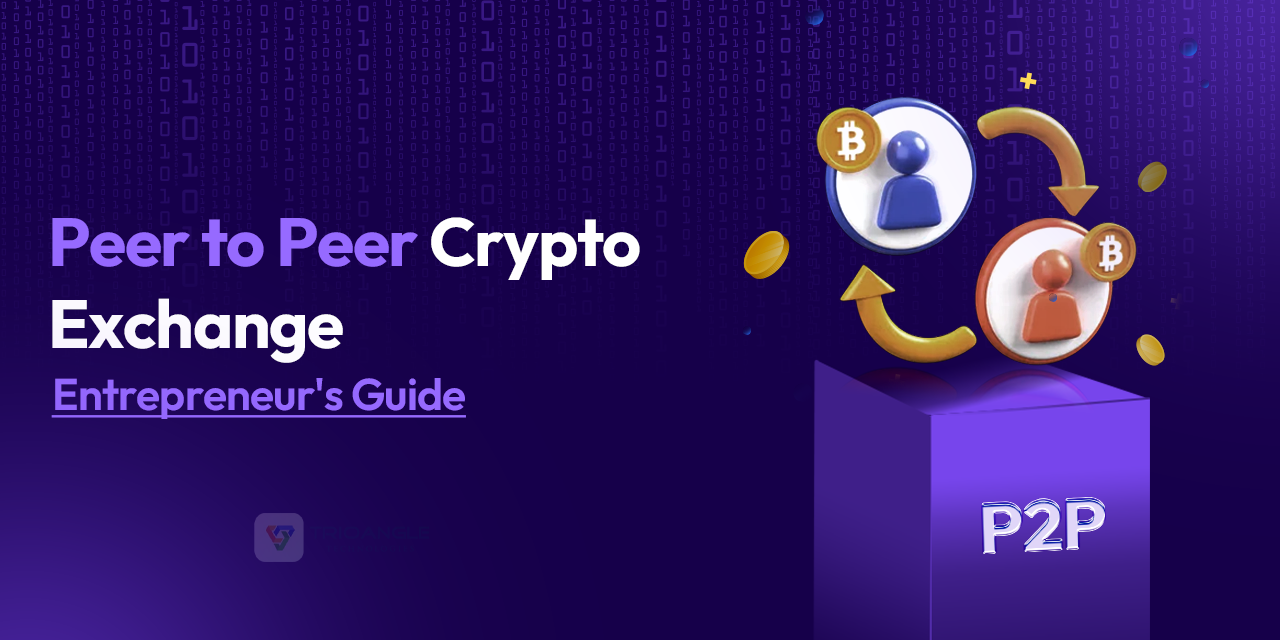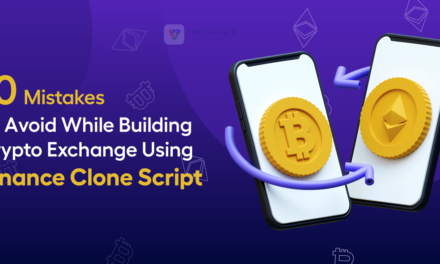The fast-growing cryptocurrency market introduced Peer to Peer crypto exchange to this world. These amazing platforms allow users to trade directly with no third-party involvement.
So, the result?
N number of users started opting for peer to peer trades. The more the number of users, the more trading fees. That’s why businesses started siding towards P2P crypto exchange software development.
The success of new entrepreneurs in the domain requires a deep understanding of P2P exchanges. The detailed information in this guide explores Peer to Peer crypto exchange fundamentals and its development procedures. Interestingly, you’ll also get to know real-time examples, revenue models, and how they work.
What is Peer to Peer Crypto Exchange?
A Peer-to-Peer (P2P) crypto exchange allows cryptocurrency users to complete transactions directly with each other without central intermediaries in the process. Users interact directly on P2P exchanges when compared to centralized platforms that both manage user money and order-matching activities autonomously. The method provides greater control and security and increased privacy for users’ assets.
Now it’s time to break down the why part.
Why need a Peer to Peer Crypto Exchange Development?
A P2P crypto exchange holds significant benefits for your business. Let’s see them below.
Greater Security: A P2P crypto exchange works without middlemen. It makes user funds safer throughout the trading process because intermediaries are eliminated.
Enhanced Privacy: Users maintain greater control over their personal information. Because they can perform direct transactions with this system.
Global Accessibility: Users from across the globe access P2P platforms for unrestricted trading activities that promote broad financial access.
Reduced Operational Costs: The absence of required infrastructure leads to decreased trading expenses through minimized operational costs.
Cross-Platform Compatibility: You can make your platform accessible anywhere with P2P crypto exchange app. This helps you to reach a greater number of users on your platform. To make a strong app development, explore this guide to cryptocurrency exchange app development.
Secure and user-centric trading solutions are attractive ventures for entrepreneurs who want to establish P2P exchanges.
How to Create a Peer to Peer Crypto Exchange Software?
A P2P crypto exchange creation process demands a perfect planning that aligns business goals, budget, and mainly, target audience.
Explore the 7-step process of creating your dream peer to peer crypto exchange platform.
- Research and Planning
Firstly, you need to do proper market research with planning. Importantly, develop your platform for your target audience. You also need to analyze competitors. This is integral to establishing a unique revenue model and helps you to set your platform apart from others.
- Regulatory Compliance
Your Peer to Peer crypto exchange software must comply with cryptocurrency trading regulations. It means it should satisfy locally and internationally. This helps your platform to prevent legal challenges.
- Designing Your Peer to Peer Crypto Exchange Software
Your P2P crypto exchange platform’s design must be focused on developing a user-friendly interface. This ensures easy trading operations of your peer to peer software.
- Peer to Peer Crypto Exchange Development
Select the appropriate tech that covers front-end and back-end operations and databases. This helps your peer to peer crypto exchange software to achieve secure and expandable performance. You can also integrate P2P crypto exchange apps with this.
- Implementing Security to your Platform
Security implementation must include the deployment of strong protection systems. You’ll be required to integrate security measures for protecting your users’ funds and data. Escrow services, 2FA, SSl Encryption, and Anti-Phishing measures are some of them.
- Testing your Peer to Peer Platform
Your testing process should be comprised of functionality tests, security tests, and performance tests. This helps to detect and fix potential problems before a launch takes place.
- Launching and Marketing
After getting successful results on testing, you can deploy your peer to peer crypto exchange software. You need to develop marketing plans to obtain customers and create an online community.
Besides building, legal advisors need to be present throughout development to guarantee platform compliance.
Real-time Examples of Peer to Peer Crypto Exchange Platforms
Users now purchase digital assets without any hassles through P2P crypto exchanges that provide smooth trading interfaces. The three significant P2P crypto exchanges working in this field are Paxful, Remitano, and LocalBitcoins.
Paxful
Paxful is a leading P2P crypto exchange known for its extensive payment options and escrow security. It supports 300+ payment methods, including bank transfers and mobile money. The platform ensures secure transactions through an escrow system and charges zero fees for buyers.
Remitano
The Peer to Peer cryptocurrency exchange Remitano maintains its main objective of simplifying and securing transactions. Because it operates in various countries that prioritize developing markets. Remitano executes safe crypto operations through escrow protection while providing trading support for Bitcoin, Ethereum, and USDT. It also enables transactions between fiat and crypto currencies. Users can access a mobile application through P2P crypto exchange technology that enables simple trading operations.
LocalBitcoins
LocalBitcoins started operations in 2012 as a leading P2P crypto exchange. It is specialized in direct trading between users. LocalBitcoins enabled peer-to-peer trading through 200+ countries while supporting different payment options. It delivers security features with escrow and two-factor authentication, which maintains the reputation of the platform.
Trending Update: In February 2024, Remitano launched its lending and staking functionalities to allow customers passive crypto income from their digital assets. It continues to grow its operations across both Africa and Asia because these regions show fast-rising crypto acceptance.
Besides all these, many developments are trending and beginning to be implemented in platforms. If you intend to learn and implement them in your business, then you should know about cryptocurrency exchange developments.
Let’s see how trades on peer to peer crypto exchange software work.
Working of Peer to Peer Crypto Exchange Software
Let’s break down the working of P2P crypto exchange platforms into 9 steps.
#1 Users sign up by providing their e-mail and mobile number.
#2 They upload their identity documents like their passport, license, or any govt-issued ID.
#3 Admin verifies and approves their accounts.
#4 Then, they can start by posting ads to buy/sell.
#5 The Buyer picks the seller by their post and starts to chat.
#6 Buyer deposits fiat to seller’s payment ID through UPI, bank transfers, or IMPS.
#7 At this time, escrow services hold the crypto till getting confirmation from the seller’s side.
#8 The Buyer attaches the payment screenshots to the buyer’s chat. After confirmation from the seller, escrow services release the crypto.
#9 The crypto gets deposited into the buyer’s wallet after a deduction of a fee from it.
Revenue Model of Peer to Peer Crypto Exchange Software Development
A successful P2P crypto exchange platform can generate revenue through multiple channels. The below-listed sources are the primary ways you can monetize its services.
- Trading Fee: You charge a percentage-based fee for every transaction that occurs within your platform. Admin alters it upon market fluctuations.
- Withdrawal Fee: When your users wish to withdraw their assets, they’re required to pay a small percentage fee. They can only withdraw it after getting approval from the Admin.
- Crypto Loans: You provide loans to your users after with an interest rate for that borrowed asset.
- Staking Charges: Users lock in their funds for a fixed or flexible period to earn rewards. You’ll deduct a percentage from that reward.
- Membership Charges: Your users subscribe to premium plans on a monthly basis. It gives reduced trading fees and fast withdrawals.
- Conversion Fee: It applies whenever users exchange one crypto for another or crypto-to-fiat or fiat-to-crypto conversions.
Alright, it’s time to know where you need to avail of these services.
Peer to Peer Crypto Exchange Development Company – Your Solution
Infrastructure development for P2P crypto exchange becomes simpler when users partner with a specialized Peer to Peer Crypto Exchange Software Development Company. You’ll be stress-free as those blockchain experts will take care of security and compliance requirements.
Peer to Peer Crypto Exchange Development Company provides specialized services that include custom platform development, white-label products, and strategic advisory services to deliver secure operation.
As crypto adoption grows, P2P exchanges remain a vital component of this financial ecosystem. So, start P2P Crypto Exchange Development now and unlock expanding earning opportunities.





